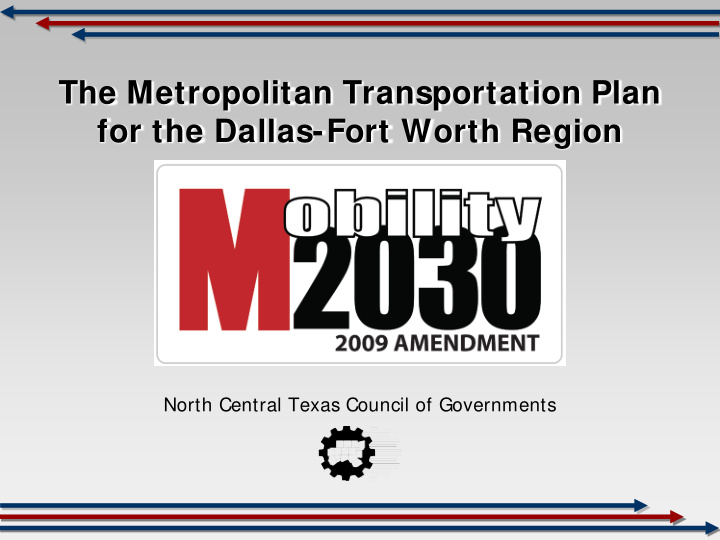



The Metropolitan Transportation Plan for the Dallas-Fort Worth Region North Central Texas Council of Governments
What is the Metropolitan Transportation Plan? • Represents a blueprint for a multimodal transportation system • Responds to adopted goals – Increased/improved mobility – Quality of life – Financial/air quality • Identifies policies, programs, and projects for continued development • Guides expenditures for federal and state funds
MTP vs. TIP There are two major transportation plans for the Dallas-Fort Worth Region • The Metropolitan Transportation Plan (MTP) – Long range vision for region’s transportation system – Identifies sources of revenue based upon reasonable assumptions think “Savings Account” • The Transportation Improvement Program (TIP) – Includes specific projects, programs, etc. to be funded in the near term – Lists specific revenue sources to fund transportation projects, programs, etc. think “Checking Account” The MTP and TIP are dependent on each other
Prioritization of Improvements Infrastructure Maintenance Maintain & Operate Existing Facilities + Management & Operations (ITS, TSM, TDM, Bike/Pedestrian) Improve Efficiency of Existing Facilities Policy Discussions Air Quality Impacts Remove Trips from System • Intermodal Planning and Financial + Efforts • System Safety Constraint are Rail & Bus • System Security Considered Throughout Induce Switch to Transit • Alternative Land Use the Process + & Growth Scenarios HOV/Managed Lanes Increase Auto Occupancy + Freeway/Tollway & Arterial Additional Vehicle Capacity = Mobility 2030 – 2009 Amendment
Financial Constraint Summary The MTP is not a “wish list” of projects for the region, it must be constrained to Mobility 2030 - 2009 available resources Amendment (Billions, Actual Dollars) Operations, Maintenance, Rehabilitation, Safety, Facility $19.8 Reconstruction Transit Operations, Maintenance $16.4 Congestion Management Process, Alternative Fuels $3.1 Bicycle, Pedestrian, Transportation Enhancements $2.1 Rail Capital* $21.6 Bus, Paratransit Capital $2.7 Regional Arterial System $7.0 Other Arterials $5.9 Freeway, Tollway, HOV , Managed System $66.9 Total $145.5 Costs are adjusted for “total project cost” and “year of expenditure” consistent with SAFETEA-LU planning requirements. “Actual Dollars” reflects the effect of inflation over time. * Includes potential Revenue from Rail North Texas/Texas Local Option Transportation Act.
Air Quality Analysis
Regional Air Quality Program Targets • High-Emitting Vehicles • Vehicle Cold Starts • Hard Accelerations • Excessive Idling • High Speeds • Low Speeds • Diesel Engines • High Level of Vehicle Miles Traveled
Performance Measures Mobility 2030 – Percent Performance Measure 2007 2009 Amendment Change Population 5,856,432 8,503,146 45.2% Employment 3,664,954 5,256,667 43.4% Lane Miles 31,069 42,015 35.2% Vehicle Miles of Travel (Daily) 151,392,421 242,006,657 59.9% Vehicle Hours of Travel (Daily) 4,018,913 6,286,974 56.4% Vehicle Hours Spent in Delay (Daily) 1,026,960 1,667,797 62.4% % Increase in Travel Time Due to Congestion 34.32% 36.11% - Annual Cost of Congestion (Billions) $4.17 $6.50 55.9%
Regional Congestion Summary Mobility 2030 – Performance Measure 2007 Percent Change 2009 Amendment 2007 Population 5,856,432 8,503,146 45.2% Employment 3,664,954 5,256,667 43.4% Lane Miles 31,069 42,015 35.2% Vehicle Miles of Travel (Daily) 151,392,421 242,006,657 59.9% Mobility 2030 – 2009 Amendment Mobility 2030 – Performance Measure 2007 Percent Change 2009 Amendment Vehicle Hours of Travel (Daily) 4,018,913 6,286,974 56.4% Vehicle Hours Spent in Delay (Daily) 1,026,960 1,667,797 62.4% % Increase in Travel Time Due to Congestion 34.32% 36.11% - Annual Cost of Congestion (Billions) $4.17 $6.50 55.9%
Recommend
More recommend